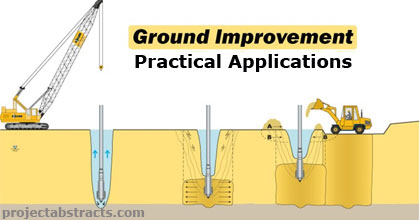Ground Improvement techniques are often used to improve sub soil properties in terms of their bearing capacity, shear strength, settlement characteristics, drainage, etc. These techniques have a wide range of applicability from coarse grained soils to fine grained soils.
Depending upon the loading conditions and nature of soil, a suitable technique which is also economical needs to be adopted. This paper gives the concept and theory of a few ground improvement techniques and describes the practical application of these techniques along with a case history for each of the techniques.
Ground Improvement Overview:
Ground improvement, is the modification of existing site foundation soils to provide better performance under design and/or operational loading conditions. Ground improvement techniques are used increasingly for new projects to allow utilization of sites with poor subsurface conditions.

Practical Applications of Ground Improvement
Previously, these poor soils were considered as economically unjustifiable or technically not feasible and are often replaced with an engineered fill or location of the project is changed. In short, Ground improvement is executed to increase the bearing capacity, reduce the magnitude of settlements and the time in which it occurs, retard seepage, accelerate the rate at which drainage occurs, increase the stability of slopes, mitigation of liquefaction potential, etc.
Ground Improvement techniques may be broadly classified in to following categories:
a) Improvement by deep vibration
b) Improvement by increasing effective stresses
c) Improvement by reinforcement
d) Improvement by structural fills
e) Improvement by admixtures
f) Improvement by grouting
g) Improvement by thermal stabilization, etc.
Source: Kellerindia
Authors: Raju V.R. | Sridhar Valluri